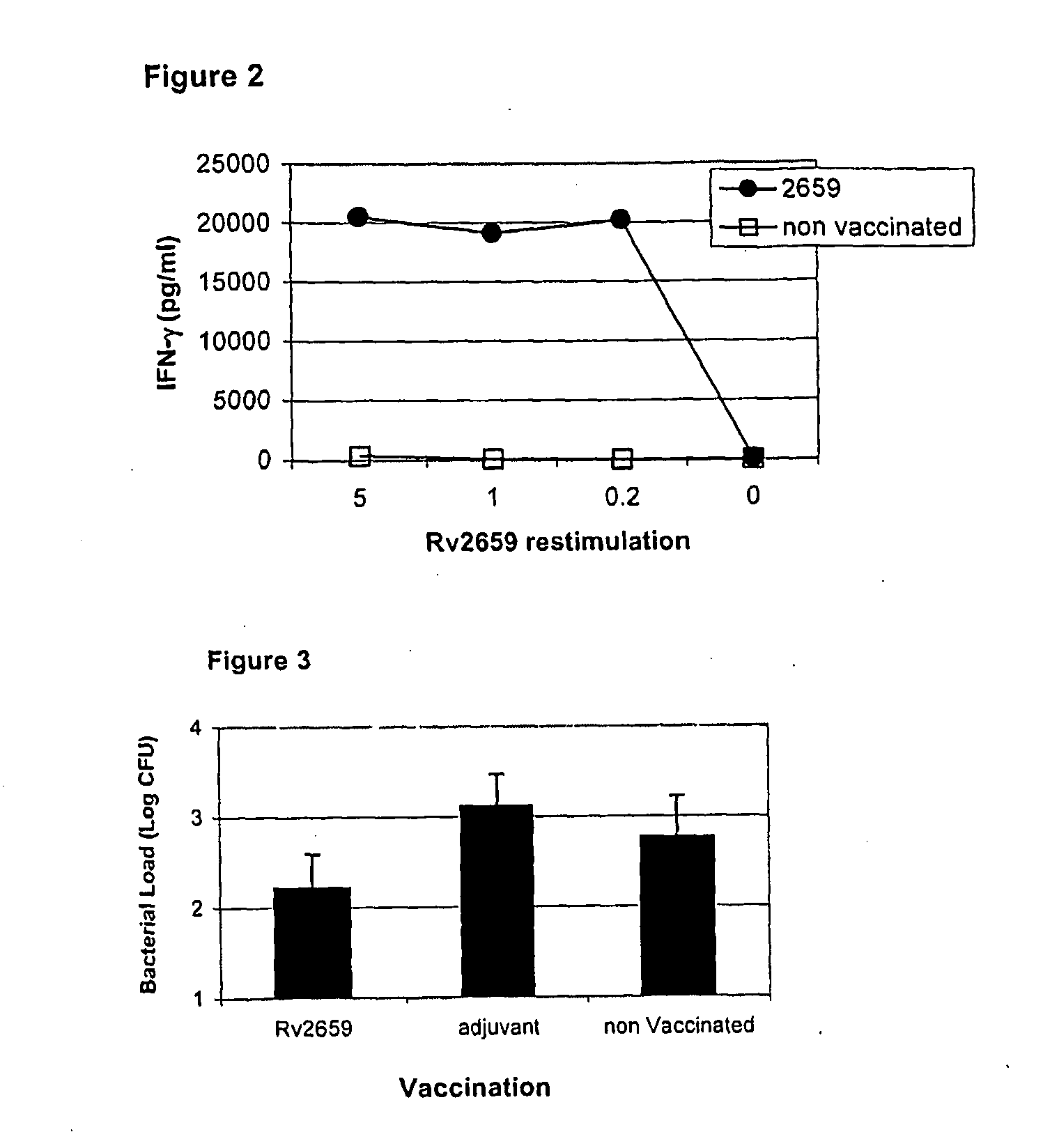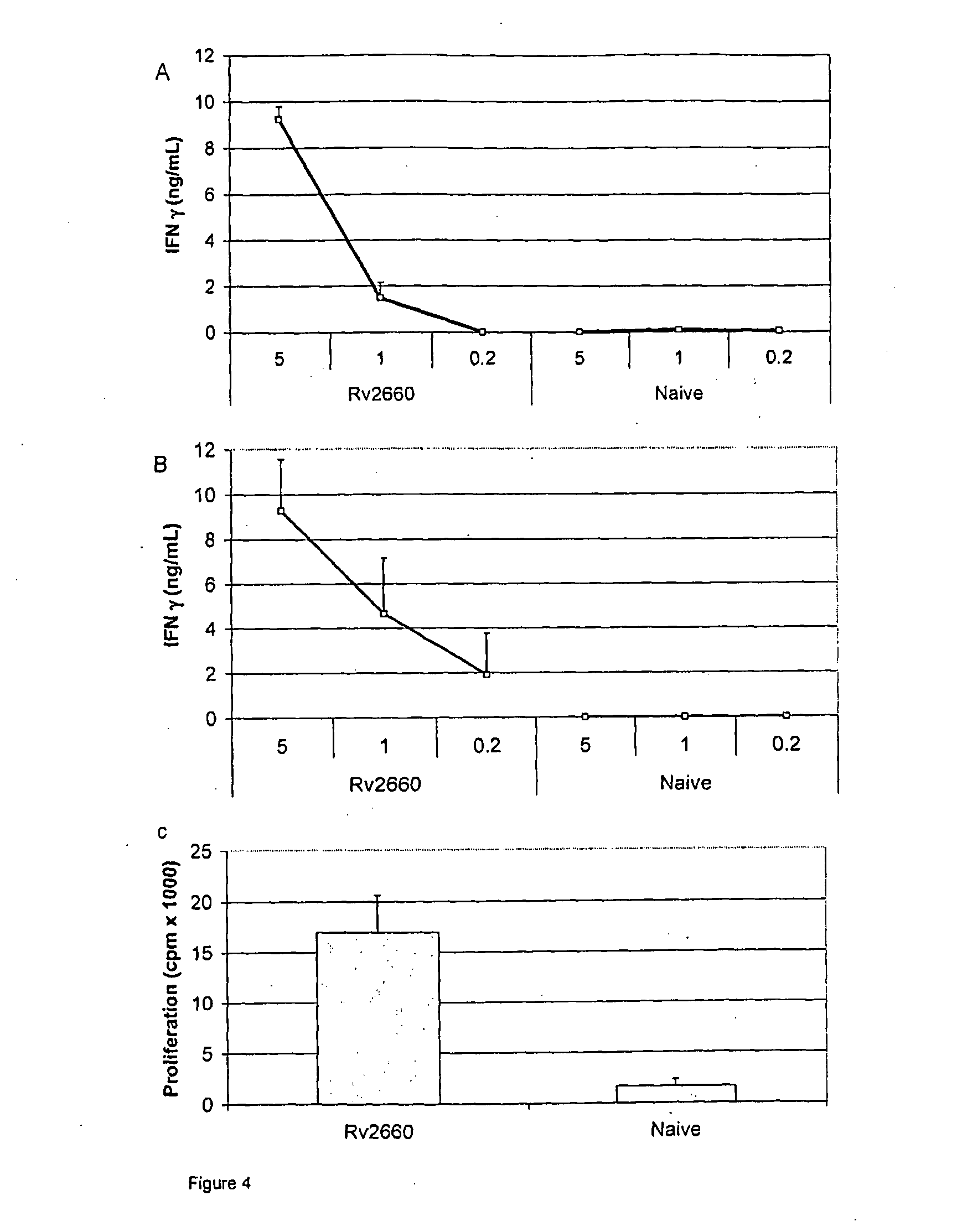Tuberculosis vaccines comprising antigens expressed during the latent infection phase
a vaccine and latent infection technology, applied in the field of starvation-induced antigens or new fusion polypeptides of immunogenic polypeptides, can solve the problems of insufficient expression of a gene to make it a good vaccine candidate, the inability to demonstrate a specific long-term protective immune response with the potency of bcg or the capability of boosting in a bcg vaccinating person, and the inability to predict the translation of dna
- Summary
- Abstract
- Description
- Claims
- Application Information
AI Technical Summary
Benefits of technology
Problems solved by technology
Method used
Image
Examples
example 1
Human Recognition of a Starvation Induced Antigen
[0122]Rv2660c was evaluated for human recognition in a panel of pulmonary TB patients from Uganda provided by the WHO Tuberculosis Specimen Bank. Both patients with negative and positive HIV infection status were included (N=94 and N=73, respectively). The control group consisted of one hundred healthy, Danish resident donors with an estimated BCG coverage >90%.
[0123]Microtiter plates were coated with 1.0 g / ml (1001 per well) Rv2660c protein incubated with 100× diluted serum samples and developed using peroxidase conjugated rabbit-anti-human Ig and tetramethylbenzidine as substrate (results in FIG. 1).
Conclusion
[0124]In this study, the recognition of a starvation-induced protein was tested. Based upon a cutoff determined from the control group using a sensitivity of 97% if was possible to confirm the TB infection in 45% of the HIV− cases and 61% of the HIV+ cases. Clearly indicating that the RV2660c protein is expressed and recognized...
example 2
Immunogenicity and Prevention of Reactivation by Post-Exposure Administration of a Starvation Induced Antigen (Rv2659c)
[0125]Mice were infected with M. tuberculosis and treated with antibiotics to reduce the bacterial burden and enter a stage of latent infection with a bacterial burden close to detection level. During the latent stage of infection the mice were vaccinated three times at two-week intervals with Rv2659c in adjuvant (e.g. DDA / MPL). One week after the final vaccination, blood cells are analyzed by ELISA for IFN-gamma secretion following stimulation with Rv2659c (FIG. 2).
[0126]The ability of the starvation induced protein Rv2659c to induce protection against reactivation of M. tuberculosis
[0127]Groups of mice with latent M. tuberculosis were subcutaneously vaccinated three times at two-week intervals with Rv2659c formulated in adjuvant (e.g. DDA / MPL) and protective efficacy were assessed by reduction in colony forming units (CFU) from lungs and spleens when compared to ...
example 3
Immunogenicity and Protection Against Aerosol M. tuberculosis Infection by the Starvation Induced Antigen Rv2660c
[0129]Mice were vaccinated three times at two-week intervals with Rv2660c in adjuvant (e.g. DDA / MPL). One week after the final vaccination, blood cells are analyzed by ELISA for IFN-gamma secretion following stimulation with Rv2660c (FIG. 4A). Three weeks after final vaccination spleen cells are analysed for IFN gamma secretion following stimulation with Rv2660c (FIG. 4B) and blood cells are analysed for antigen specific proliferative responses (FIG. 4C)
[0130]Groups of mice subcutaneously vaccinated three times at two-week intervals with Rv2660c formulated in adjuvant (e.g. DDA / MPL) were challenged by aerosol infection with M. tuberculosis and the protective efficacy was assessed by reduction in colony forming units (CFU) isolated from lungs when compared to non-vaccinated mice. Protection was evaluated 12 weeks after vaccination. Rv2660c induced ½ log(10) reduction in pu...
PUM
| Property | Measurement | Unit |
|---|---|---|
| Digital information | aaaaa | aaaaa |
| Digital information | aaaaa | aaaaa |
| Digital information | aaaaa | aaaaa |
Abstract
Description
Claims
Application Information
 Login to View More
Login to View More - R&D
- Intellectual Property
- Life Sciences
- Materials
- Tech Scout
- Unparalleled Data Quality
- Higher Quality Content
- 60% Fewer Hallucinations
Browse by: Latest US Patents, China's latest patents, Technical Efficacy Thesaurus, Application Domain, Technology Topic, Popular Technical Reports.
© 2025 PatSnap. All rights reserved.Legal|Privacy policy|Modern Slavery Act Transparency Statement|Sitemap|About US| Contact US: help@patsnap.com



